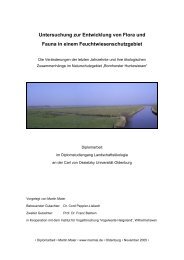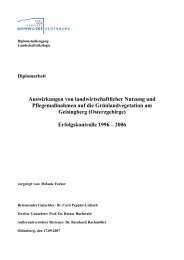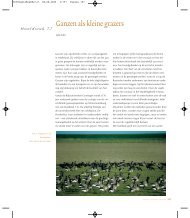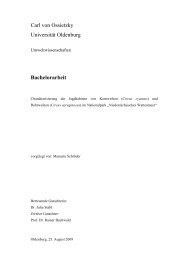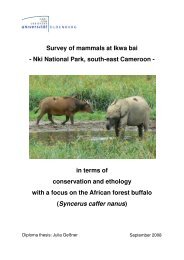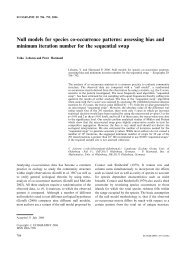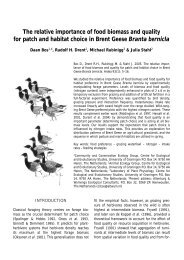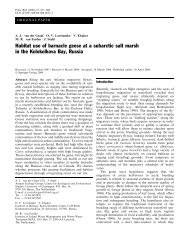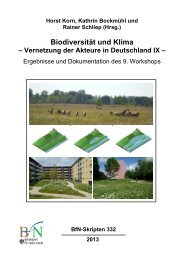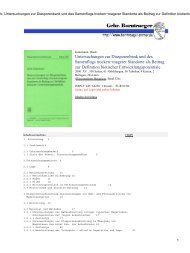The use of habitat models in conservation of rare and endangered ...
The use of habitat models in conservation of rare and endangered ...
The use of habitat models in conservation of rare and endangered ...
You also want an ePaper? Increase the reach of your titles
YUMPU automatically turns print PDFs into web optimized ePapers that Google loves.
248<br />
occurrence probability at given parameter values.<br />
To dist<strong>in</strong>guish between predicted presence <strong>and</strong><br />
absence, a threshold probability needs to be def<strong>in</strong>ed.<br />
Predictions should stay restricted to the<br />
range <strong>of</strong> parameter values that has been covered<br />
by the study.<br />
Measures <strong>of</strong> model performance<br />
Numerous measures assess<strong>in</strong>g performance <strong>of</strong><br />
logistic regression <strong>models</strong> are available (Hosmer<br />
<strong>and</strong> Lemeshow 2000; Pearce <strong>and</strong> Ferrier 2000a;<br />
Manel et al. 2001). All <strong>of</strong> them can only describe<br />
certa<strong>in</strong> aspects <strong>of</strong> model performance. <strong>The</strong>refore,<br />
we <strong>use</strong>d a set <strong>of</strong> criteria, threshold-<strong>in</strong>dependent as<br />
well as threshold-dependent (Manel et al. 1999b).<br />
<strong>The</strong> difference between predicted <strong>and</strong> observed<br />
values (model calibration) was measured by R 2 N<br />
(Nagelkerke 1991). Like R 2 <strong>in</strong> l<strong>in</strong>ear regression, it<br />
ranges from 0 to 1. On an univariate level, we <strong>use</strong>d<br />
R 2 N to compare the relative <strong>in</strong>fluence that s<strong>in</strong>gle<br />
predictor variables had on species’ presence.<br />
Model discrim<strong>in</strong>ation was assessed with AUC<br />
(Hanley <strong>and</strong> McNeil 1982), the Area Under the<br />
receiver operat<strong>in</strong>g characteristic Curve (AUC).<br />
AUC values ‡0.7 are regarded as acceptable, ‡0.8<br />
as excellent, <strong>and</strong> ‡0.9 as outst<strong>and</strong><strong>in</strong>g (Hosmer <strong>and</strong><br />
Lemeshow 2000).<br />
Sensitivity (proportion <strong>of</strong> correctly predicted<br />
presences), specificity (proportion <strong>of</strong> correctly<br />
predicted absences) <strong>and</strong> CCR (correct classification<br />
rate) are classification threshold dependent<br />
measures. CCR is easy to <strong>in</strong>terpret, however largely<br />
dependent on the rather arbitrary choice <strong>of</strong> a<br />
threshold (Re<strong>in</strong>ek<strong>in</strong>g <strong>and</strong> Schro¨ der 2003) <strong>and</strong><br />
should be h<strong>and</strong>led with care. As a threshold, we<br />
chose P fair , where specificity <strong>and</strong> sensitivity are<br />
equivalent (Hosmer <strong>and</strong> Lemeshow 2000). S<strong>in</strong>ce<br />
the species under study are <strong>rare</strong> <strong>and</strong> their prevalence<br />
is low, P fair ensures that a reasonable proportion<br />
<strong>of</strong> presences will be predicted correctly. On<br />
the other h<strong>and</strong>, this may result <strong>in</strong> a lower total<br />
number <strong>of</strong> correct predictions (lower CCR) <strong>and</strong>, <strong>in</strong><br />
particular, more predicted presences for observed<br />
absences (lower specificity) than with other<br />
thresholds. For nature <strong>conservation</strong>, where <strong>of</strong>ten<br />
the aim will be to correctly predict as many relevant<br />
<strong>habitat</strong>s patches as possible (Morrison et al.<br />
1998), we believe that the advantages <strong>of</strong> P fair outrun<br />
these disadvantages.<br />
S<strong>in</strong>ce CCR, sensitivity <strong>and</strong> specificity are highly<br />
dependent on the species’ prevalence (Manel et al.<br />
2001), we <strong>use</strong>d Cohen’s Kappa j (Cohen 1960) as<br />
another, less sensitive threshold-dependent measure<br />
(Field<strong>in</strong>g <strong>and</strong> Bell 1997). Kappa ranges from<br />
0 to 1 with values between 0.40 <strong>and</strong> 0.55 <strong>in</strong>dicat<strong>in</strong>g<br />
fair agreement <strong>and</strong> values between 0.55 <strong>and</strong> 0.70<br />
<strong>in</strong>dicat<strong>in</strong>g good agreement between observed <strong>and</strong><br />
predicted values (Monserud <strong>and</strong> Leemans 1992).<br />
For comparison between <strong>models</strong> we <strong>use</strong>d the<br />
<strong>in</strong>formation criterion AIC c , a version <strong>of</strong> AIC<br />
(Akaike’s Information Criterion) modified for<br />
small samples (Buckl<strong>and</strong> et al. 1997). AIC <strong>in</strong>dicates<br />
how well a model performs the trade-<strong>of</strong>f<br />
between model fit <strong>and</strong> model complexity.<br />
Model build<strong>in</strong>g<br />
As recommended by Hosmer <strong>and</strong> Lemeshow<br />
(2000), we performed careful univariate analyses<br />
prior to build<strong>in</strong>g <strong>of</strong> multivariate <strong>models</strong>. For<br />
each species, we tested univariate <strong>models</strong> <strong>of</strong> all<br />
variables. Only significant variables (p £ 0.05)<br />
with R 2 N ‡ 0.05 were considered for further<br />
analysis.<br />
A popular approach for build<strong>in</strong>g multivariate<br />
<strong>models</strong> <strong>use</strong>s stepwise procedures for variable<br />
selection. Pearce <strong>and</strong> Ferrier (2000b) recommend<br />
the stepwise backward procedure, which we <strong>use</strong>d<br />
for the Verdanus bensoni study. In general, all<br />
stepwise procedures have some disadvantages<br />
(Re<strong>in</strong>ek<strong>in</strong>g <strong>and</strong> Schro¨ der 2004). <strong>The</strong>y might not<br />
f<strong>in</strong>d the best model, or selection is unstable <strong>and</strong><br />
does not hold for slightly different data. With a<br />
large number <strong>of</strong> predictor variables, like <strong>in</strong> the<br />
brownfield study, stepwise procedures perform<br />
poorly. <strong>The</strong>refore, <strong>in</strong> that study, we followed a<br />
different approach: we calculated <strong>models</strong> for all<br />
comb<strong>in</strong>ations <strong>of</strong> four, three <strong>and</strong> two parameters,<br />
us<strong>in</strong>g Splus 6.1 functions glm <strong>and</strong> stepAIC (MASS<br />
library). S<strong>in</strong>ce the ratio ‘number <strong>of</strong> observations’/<br />
‘predictor variables’ should not fall much below 10<br />
(Morrison et al. 1998; Guisan <strong>and</strong> Zimmermann<br />
2000), more than four variables per model are not<br />
a sound choice for the available data sets.<br />
Strong correlations between predictor variables<br />
will lead to abnormally high coefficients <strong>and</strong><br />
st<strong>and</strong>ard errors (Neter et al. 1989). <strong>The</strong>refore,<br />
maximum spearman rank correlation (r S ) between<br />
predictor variables with<strong>in</strong> one model was allowed<br />
to be 0.7 (Field<strong>in</strong>g <strong>and</strong> Haworth 1995). S<strong>in</strong>ce<br />
height <strong>and</strong> density parameters <strong>in</strong> the brownfield<br />
study showed strong correlations, only one <strong>of</strong> each<br />
group was chosen for multivariate model<strong>in</strong>g.




